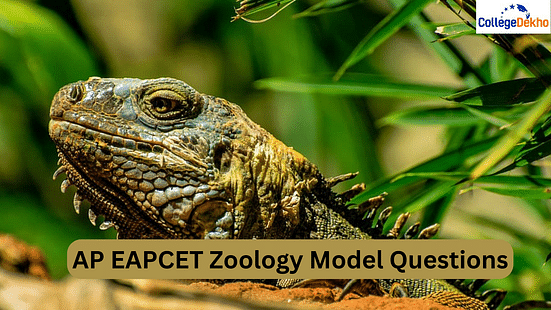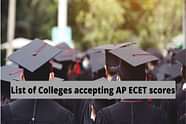
It’s no secret that solving model questions for subjects like Botany, Physics, Chemistry, and Zoology will help you ace the AP EAPCET exam . By practising such questions on a regular basis, you will become familiar with the topics that are frequently asked during the AP EAPCET Agriculture exam . Moreover, these model questions also help in analysing the sections that have the highest weightage in the exam and also give a boost to your confidence level. As a result, you will be much more relaxed on exam day and overcome any exam stress.
Also Read:
AP EAPCET Model Questions of Zoology
Applicants can check the following practice questions and answers from the below table.
Questions | Options | Correct Answer | Explanation |
|---|---|---|---|
The study related to human origin and characteristics and their societies is: |
a) Anthropology
b) Eugenics c) Euphenics d) Humanities | Anthropology | |
Photochordates without blood corpuscles and heart are: |
a) Ascidians
b) Larvaceans c) Thaliaceans d) Lancelets | Lancelets | |
Which of the following is a connecting link between Annelida and Arthropoda? |
A) Peripatus
B) Limulus C) Nereis D) Palaemon | Peripatus | Peripatus has characteristics of both Annelids (segmented body) and Arthropods (tracheae and appendages). |
Malpighian tubules are excretory organs in: |
A) Earthworm
B) Cockroach C) Frog D) Human | Cockroach | In cockroaches, Malpighian tubules are responsible for removal of nitrogenous wastes. |
Viviparous living fossil is: |
a) Sphenodon
b) Latimeri c) Neopilina d) Limulus | Latimeria | |
Which theory of evolution suggests that organisms evolve by inheriting traits that are acquired during their lifetime? |
a) Lamarckism
b) Darwinism c) Mutation Theory d) Modern Synthetic Theory | Lamarckism | |
The serous membrane covering the lungs is: |
A) Pericardium
B) Peritoneum C) Pleura D) Meninges | Pleura | Pleura is the double-layered membrane that covers lungs and lines the chest cavity. |
The Modern Synthetic Theory of Evolution combines the principles of Darwin’s theory with: |
a) Mendelian genetics
b) Lamarckism c) Gene flow d) Hardy -Weinberg Law | Mendelian genetics | |
Kettlewell’s experiments on Biston betularia (peppered moth) are an example of: |
a) Mutation theory
b) Natural selection c) Adaptive radiation d) Genetic recombination | Natural selection | |
Which one of the following is a vestigial organ in humans? |
A) Liver
B) Pancreas C) Appendix D) Kidney | Appendix | The appendix has lost its original function and is considered a vestigial organ. |
In Darwin’s theory of evolution, which of the following is a key mechanism that drives natural selection? |
a) Overproduction of offspring
b) Genetic drift c) Human intervention d) Gene flow | Overproduction of offspring | |
Headquarters of Urodeles is |
a) South Africa
b) South America c) Australia d) North America | North America | |
Which of the following is considered one of the strongest pieces of evidence for biological evolution? |
A. Fossil evidence
B. Genetic mutations C. Human artificial selection D. Artificial breeding | Fossil evidence | |
What is the mode of action of enzyme pepsin? |
A) Breaks down starch
B) Breaks down lipids C) Breaks down proteins into peptides D) Breaks down DNA | Breaks down proteins into peptides | Pepsin is a proteolytic enzyme that acts in the stomach. |
The pacemaker of the heart is: |
A) AV Node
B) Purkinje fibers C) Bundle of His D) SA Node | SA Node | The sinoatrial (SA) node initiates the heartbeat and regulates its pace. |
Which of the following is an example of adaptive radiation? |
A. Darwin’s finches
B. Kettlewell’s experiment on peppered moths C. The development of antibiotic resistance in bacteria D. The development of human races | Darwin’s finches | |
Which of the following animals is known as a living fossil? |
A. Latimeria
B. Neopilina C. Limulus D. All of the above | All of the above | |
The term 'Anthropology' is related to the study of: |
A. Plants
B. Animals C. Humans D. Microorganisms | Humans | The descending limb of the loop of Henle is highly permeable to water. |
In a nephron, reabsorption of water occurs mainly in: |
A) Bowman's capsule
B) Collecting duct C) Loop of Henle D) Glomerulus | Loop of Henle | |
The scientific name of the Indian Peacock is: |
A. Pavo cristatus
B. Gallus gallus C. Corvus splendens D. Columba livia | Pavo cristatus | |
Which of the following is a characteristic feature of Urochordates? |
A. Notochord present throughout life
B. Notochord present only in larval tail C. Notochord present in both larval and adult stages D. Absence of notochord | Notochord present only in larval tail | |
Which type of immunity is obtained after vaccination? |
A) Natural active
B) Natural passive C) Artificial active D) Artificial passive | Artificial active | Vaccination induces artificial active immunity by stimulating antibody production. |
Which of the following is not a mammalian characteristic? |
A. Presence of mammary glands
B. Three -chambered heart C. Hair on the body D. Diaphragm separating thoracic and abdominal cavities | Three-chambered heart | |
Which phylum does the animal 'Obelia' belong to? |
A. Porifera
B. Cnidaria C. Platyhelminthes D. Annelida | Cnidaria | |
Which type of muscle is involuntary and striated? |
A. Skeletal
B. Smooth C. Cardiac D. Voluntary | Cardiac | Cardiac muscle is involuntary but shows striations under the microscope |
The excretory organs in annelids are |
A. Nephridia
B. Malpighian tubules C. Flame cells D. Kidneys | Nephridia | |
Which part of the brain controls voluntary actions? |
A. Medulla oblongata
B. Cerebellum C. Cerebrum D. Hypothalamus | Cerebrum | Cerebrum controls all voluntary functions like movement, thought, and speech |
Which of the following is a connecting link between Annelida and Arthropoda? |
A. Peripatus
B. Balanoglossus C. Limulus D. Neopilina | Peripatus | |
Which gland secretes insulin? |
A. Thyroid
B. Pancreas C. Pituitary D. Adrenal | Pancreas | Insulin is secreted by the beta cells of the pancreas |
Which disease is caused by Plasmodium? |
A. Dengue
B. Malaria C. Filariasis D. AIDS | Malaria | Plasmodium is a protozoan parasite that causes malaria |
Which of the following is not a characteristic of mammals? |
A. Three middle ear bones
B. Nucleated red blood cells C. Hair D. Mammary glands | Nucleated red blood cells | |
The largest phylum in the animal kingdom is: |
A. Mollusca
B. Chordata C. Arthropoda D. Echinodermata | Arthropoda | |
Which WBCs are involved in allergic reactions? |
A. Neutrophils
B. Basophils C. Monocytes D. Erythrocytes | Basophils | Basophils release histamine during allergic responses. |
The hormone responsible for regulating calcium levels in the blood is |
A. Insulin
B. Glucagon C. Parathyroid hormone D. Thyroxine | Parathyroid hormone | |
The functional unit of the kidney is |
A. Nephron
B. Neuron C. Alveolus D. Glomerulus | Nephron | |
Which vitamin helps in blood clotting? |
A. Vitamin A
B. Vitamin D C. Vitamin E D. Vitamin K | Vitamin K | Vitamin K is essential for synthesis of clotting factors. |
Which of the following enzymes is present in saliva? |
A. Pepsin
B. Trypsin C. Amylase D. Lipase | Amylase | Salivary amylase breaks down starch into maltose. |
Which of the following is a sexually transmitted disease? |
A. Tuberculosis
B. Hepatitis B C. Gonorrhea D. Typhoid | Gonorrhea | |
The largest organ in the human body is: |
A. Liver
B. Skin C. Heart D. Lung | Skin | |
Which vitamin is synthesized by the skin upon exposure to sunlight? |
A. Vitamin A
B. Vitamin B12 C. Vitamin C D. Vitamin D | Vitamin D | |
Which is the primary site of RBC production in adults? |
A. Liver
B. Spleen C. Bone marrow D. Kidney | Bone marrow | In adults, red bone marrow is the main site for hematopoiesis |
The process by which white blood cells engulf bacteria is called: |
A. Pinocytosis
B. Phagocytosis C. Exocytosis D. Endocytosis | Phagocytosis | |
Which part of the nephron is responsible for selective reabsorption? |
A. Glomerulus
B. Proximal convoluted tubule C. Loop of Henle D. Distal convoluted tubule | Proximal convoluted tubule | Most reabsorption of water, ions, and nutrients occurs in the PCT |
Which of the following is a water-soluble vitamin? |
A. Vitamin A
B. Vitamin D C. Vitamin E D. Vitamin C | Vitamin C | |
Which of the following animals is ureotelic? |
A. Frog
B. Bird C. Insect D. Reptile | Frog | Ureotelic animals excrete urea; frogs excrete urea, whereas birds and insects are uricotelic |
Which hormone is known as anti-diuretic hormone (ADH)? |
A. Oxytocin
B. Vasopressin C. Insulin D. Glucagon | Vasopressin | Vasopressin (ADH) reduces urine output by promoting water reabsorption in the kidneys. |
The basic contractile unit of a muscle fiber is: |
A. Sarcolemma
B. Sarcoplasm C. Sarcomere D. Sarcoplasmic reticulum | Sarcomere | |
The largest part of the human brain is: |
A. Cerebellum
B. Cerebrum C. Brainstem D. Thalamus | Cerebrum | |
Which of the following is not a connective tissue? |
A. Blood
B. Cartilage C. Tendon D. Skin | Skin | Skin is an organ, not a connective tissue. Blood, cartilage, and tendon are all connective tissues. |
Which of the following is an example of a hinge joint? |
A. Shoulder
B. Hip C. Elbow D. Neck | Elbow | |
Which structure in the eye regulates the size of the pupil? |
A. Cornea
B. Iris C. Retina D. Lens | Iris | Iris controls the diameter of the pupil and thus the amount of light entering the eye |
What is the function of hemoglobin? |
A. Immunity
B. Digestion C. Oxygen transport D. Clotting | Oxygen transport | Hemoglobin in RBCs binds oxygen and transports it throughout the body |
AP EAPCET Zoology Chapter Wise Weightage
The chapter-wise breakup of the high-weightage topics of zoology can be checked here from the below table.
Topics | Expected Weightage | 2024 Questions | 2023 Questions |
|---|---|---|---|
Diversity of Living World | 1-2 Questions | 2 | 1 |
Structural Organization in Animals | 0-1 Questions | 1 | 1 |
Animal Diversity-I: Invertebrate Phyla | 2-3 Questions | 3 | 2 |
Animal Diversity-Ii: Phylum Chordata | 1-2 Question | 1 | 2 |
Locomotion & Reproduction in Protozoa | 2-3 Question | 2 | 3 |
Biology & Human Welfare | 2-3 Questions | 4 | 3 |
Type Study of Periplaneta Americana | 1-2 Questions | 1 | 2 |
Ecology & Environment | 4-5 Questions | 3 | 5 |
Human Anatomy And Physiology-I | 3-4 Questions | 3 | 3 |
Human Anatomy And Physiology-Ii | 2-3 Question | 2 | 3 |
Human Anatomy And Physiology-Iii | 2-3 Question | 2 | 2 |
Human Anatomy And Physiology-IV | 2-3 Question | 3 | 3 |
Human Reproduction | 5-6 Questions | 4 | 5 |
Genetics | 3-4 Questions | 4 | 3 |
Organic Evolution | 2-3 Question | 3 | 1 |
Applied Biology | 1-2 Question | 2 | 1 |
Also Read:
| AP EAPCET Zoology Topic-wise Weightage | AP EAPCET Botany Model Questions |
|---|---|
| AP EAPCET Botany Topic-wise Weightage | |
Books to Cover Zoology Important Topics for AP EAMCET
Here are the names of the best books along with their authors to prepare more effectively for the AP EAMCET zoology section.
- Narayan Biology Series by Narayana Educational Institutions
- Cengage Biology for NEET – Objective Series by Cengage Publications
- NEET 33 Years Chapterwise Biology Questions by Arihant
- MTG Objective NCERT at Your Fingertips – Biology by MTG Learning Media
- GRB A Textbook of Biology by Dr. H.C. Verma
As experienced tutors say ‘Practice is the key to success’, we can conclude that revision of important concepts and practising AP EAPCET zoology model questions will allow you to sail over this exam quite confidently. We wish all aspirants good luck with their exams.
Still having queries about AP EAPCET exam? Post it on our QnA zone . You can also talk to us by dialling our toll-free number 1800-572-9877.
Are you feeling lost and unsure about what career path to take after completing 12th standard?
Say goodbye to confusion and hello to a bright future!

FAQs
In the AP EAPCET exam, you will be asked about 40 questions from Zoology.
The high-weightage topics for AP EAPCET from the Zoology section are human reproduction, organic evolution, genetics, ecology & environment, locomotion & reproduction in protozoa and human anatomy and physiology.
Was this article helpful?



















Similar Articles
Tamil Nadu BSc Agriculture (TNAU) Admission: Application Forms (OUT), Last Date (Jun 8), Eligibility, Ranking Process, Counselling
Bihar Agriculture Admissions (BCECE) 2025: Dates (OUT), Application Form (closed), Admit Card (OUT), Results, Counseling
Uttar Pradesh BSc Agriculture Admission: UG Exam on Jun 11, Admit Card (OUT), Results, Counselling
Tripura BSc Agriculture Admission: Dates, Application Process, Eligibility, Top Colleges, Counselling
List of Documents Required to Fill UPCATET 2025 Application Form: Important Dates, Steps to Fill the Form
Odisha BSc Agriculture Admission 2025: Dates (Jun 2-3), Application Form (Closed), Admit Card (OUT), Eligibility, Process, Results, Counselling & Latest Updates